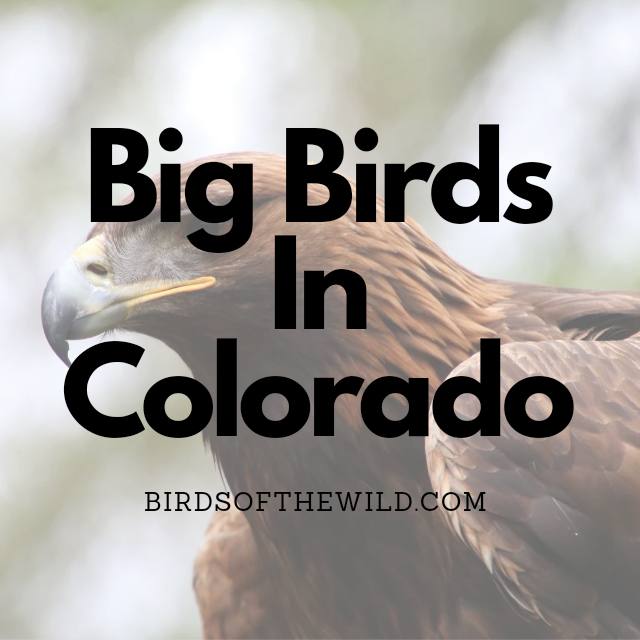Big birds can be found in many different regions in Colorado, where in this article I’ll simply be going over 7 unique big birds that consider this state home.
- Snowy Owl
- Great Horned Owl
- Bald Eagle
- Golden Eagle
- Turkey Vulture
- Double Crested Cormorant
- Sandhill Crane
7 Big Birds In Colorado
1. Snowy Owl (Bubo Scandiacus)
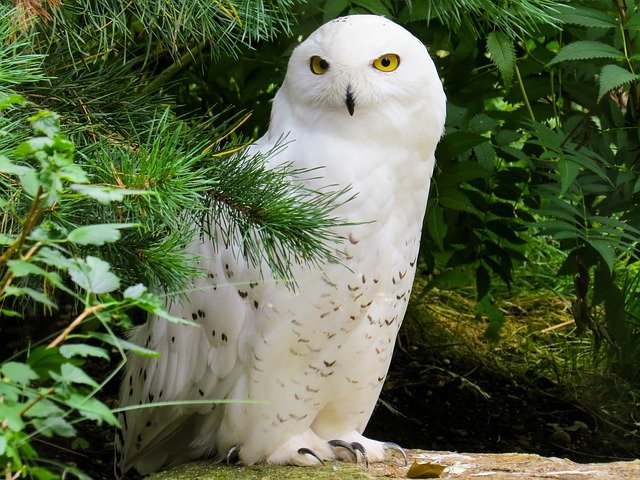
- Size: 52 – 71cm
- Weight: 1.1 – 2kg
- Wingspan: 125 – 164cm
Snowy owls are mostly winter and fall residents within the state of Colorado. This also coincides with their non breeding months.
These owls are recognised by their mostly white plumage with brown dots throughout the body. Females on the other hand are generally less white than the males as the brown spots encompass more of their body.
Snowy owls tend to spend their time within arctic tundra or open grasslands and fields, whilst avoiding forested areas.
As for what they eat, it includes lemmings and a variety of small mammals. Nevertheless, they will still occasionally eat larger mammals like like hares, rats, rabbits, etc.
Snowy owls have been observed to live for around 28 years in captivity and between 10+ years in the wild.
2. Great Horned Owl (Bubo Vrginianus)

- Size: 57 – 63cm
- Weight:1 .4 – 15kg
- Wingspan: 1.35 – 1.5m
Great horned owls can be spotted in Colorado on a year round basis as it’s a permanent place of residence for them in the states.
These large horned owls are recognised by their brown/gray plumage with their defining feature being the tuft of feather on the top of their head resembling a horn or ear like feature. Male and female great horned owls look relatively the same with the females slightly larger in size.
At night these birds will perch on a branch or a tall building to look around for prey and once the desired prey has been found they will fly towards it with folded wings, grab the prey with their talons piercing through their body and in most cases killing them immediately.
As for what these birds eat it includes smaller prey like rodents, frogs or scorpions. Even other larger predators like geese, ducks, hawks, and smaller owls can be eaten by these carnivorous birds.
Great horned owls are most commonly found in deserts, wetlands, forests, grasslands, backyards, cities and they can also be found in semi-open habitats between the Arctic and the tropics.
As for a great horned owls lifespan, it can be anywhere from 15 -25 years.
3. Bald Eagle (Haliaeetus Leucocephalus)

- Size: 90 – 108cm
- Weight: 3 – 6.3kg
- Wingspan: 180 – 250cm
Bald eagles are mostly winter and fall residents within Colorado although there are regions near the north west area of the state where bald eagles may inhabit Colorado year round.
A bald eagle’s plumage consists of dark brown around its wing and body, with white feathers on its tail and head along with the trademark yellow beak and feet. Both male and female bald eagles look relatively the same.
As for where you can find these eagles, it will often be around lakes and reservoirs with lots of fish and surrounding forests. You’ll often find them around unfrozen lakes and hunting along coastlines, reservoirs, and rivers during the winter months
These eagles are birds of prey meaning they hunt other birds, medium sized mammals like rabbits, hares, other animals like reptiles, fish and even eat carrion when their options are limited. Sometimes bald eagles are recognised as fish eagles as their diet consists of fish and as meat is the only thing they eat these eagles would ultimately be regarded as carnivores too.
Bald eagles can live for around 20 years in the wild.
4. Golden Eagle (Aquila Chrysaetos)
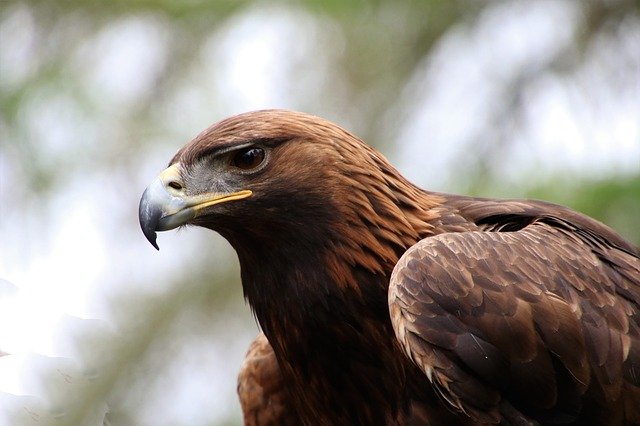
- Size: 70 – 82cm
- Weight: 3.7 – 5.3kg
- Wingspan: 190 – 212cm
You’ll be able to spot golden eagles all throughout Colorado on a year round basis.
Golden eagles are recognised by their mostly light brown and dark brown plumage, yellow feet and black downwards pointing beak. Females once again are the larger of the 2 birds where males are roughly 33% smaller in size.
These eagles spend the majority of their time within open moorlands and mountains within the likes of Scotland, and many areas within north America
Golden eagles do eat carrion but, it isn’t their first choice of food when hunting for prey. If they do find a dead carcass they will eat it, with their general food choices consisting of smaller mammals, birds and sometimes larger prey.
These eagles are known to live for around 14 years in the wild whilst captive are even able stay alive till their early 30’s with the longest observed at 32 years old.
5. Turkey Vulture (Cathartes Aura)
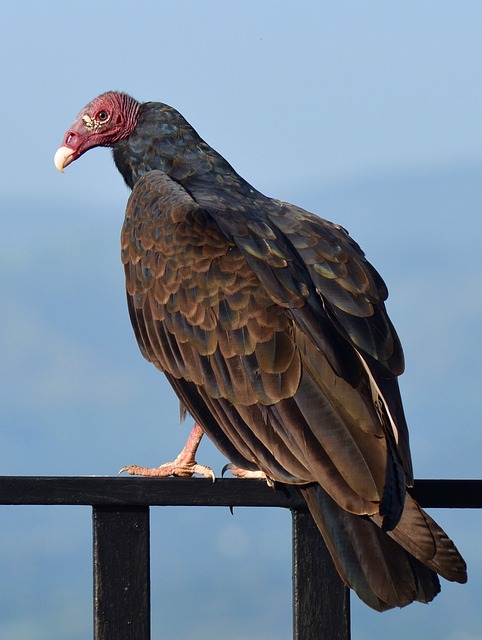
- Size: 62 – 81cm
- Weight: 1.5 – 2 kg
- Wingspan: 1.6 – 1.8m
You’ll typically spot turkey vultures in Colorado when they happen to breed.
Turkey vultures have a plumage that is mostly brownish/black in color with silver/gray lining on the underside of their wings adding a contrast to their overall appearance. The face is pink/red with elements of black on the head topped of with a pale white beak.
These scavengers are mono-morphic so they do look the same with the only differentiating aspect being their sexual organs.
Turkey vultures are scattered throughout north America where they can be found staying within open and forested habitats where they will also stay within lower elevation mountain ranges.
Carrion is a turkey vultures primary food source but, they do also eat dead reptiles, birds, amphibians and invertebrates. As a whole these vultures do prefer fresher carrion but, like other vultures they can consume the same carcass over several days.
Turkey vultures are known to live for around 16 years in the wild and up to 30 years in captivity.
6. Double Crested Cormorant (Phalacrocorax Auritus)
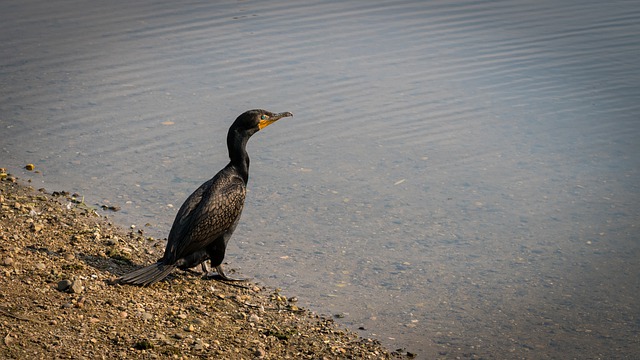
- Size: 70 – 90cm
- Weight: 1.2 – 2.5 kg
- Wingspan: 114 – 123cm
Double crested cormorants can be spotted in the north western regions of Colorado when breeding, whilst they’ll typically make their migratory passage to a breeding or wintering residence through the rest of the state.
These double crested cormorants are recognised by their mostly black plumage, slightly bulky body, a lower yellow bill and gray upper bill. Females aren’t completely black like the males where there breast and above is a more lighter gray color.
Double crested cormorant can be found spending their time around coasts, bays, lakes and rivers
These birds will often consume mostly fish, but can also eat the occasional insect, crustacean and amphibians.
Double crested cormorants are known to live for around 15 – 20 years in the wild, with some of the ones living the longest achieving 24 years in the wild.
7. Sandhill Crane (Grus Canadensis)

- Size: 91 – 151cm
- Weight: 2.72 – 6.34kg
- Wingspan: 150 – 190cm
Sandhill cranes will just be making their migratory passage throughout Colorado however, nearer the North western region of the state, these cranes may decide to stick around to breed.
Sandhill cranes whether the lesser or greater variant are recognised by their gray and brown plumage, their long neck and legs as well as the red spot on their face. They also have a jet black beak. Males are generally bigger than the females whilst the females don’t have any red spots near the eyes and beak.
These cranes tend to spend the majority of their time at open habitats within small bogs, marshes, and prairies. They will also build nests within the same areas they inhabit, but ideally would want the area to be isolated.
Sandhill cranes eat mostly seeds, grains, insects and small animals like worms, mice, small birds, snakes, lizards, frogs and crayfish.
These cranes have a lifespan that extends upto 20 years in the wild.
Amhil Khan, a dedicated nature enthusiast and the founder of BirdsOfTheWild.com, is a passionate advocate for the captivating world of avian wonders. With a deep-seated curiosity about the intricate lives of birds, Amhil’s journey began as a fascination and has evolved into a mission to inspire others to appreciate and protect these magnificent creatures.
Amhil’s love for birds led to the creation of Birds of the Wild, a platform where his expertise in ornithology, coupled with his captivating storytelling, provides readers with an immersive and educational experience. Through his lens and words, he captures the essence of birds in their natural habitats, offering a glimpse into their behaviors, migrations, and the ecosystems they inhabit.

